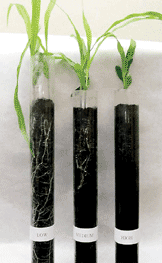|
|||||||||
Save Your Soil!Easy does it when you till or turnA friend visiting my farm commented that I needed to do more tilling in my garden. My soil was lumpy, he said, and there were pieces of grass protruding through the surface. In his own garden, he rototills his soil until it is pulverized, soft and fluffy. To a seasoned farmer, such tilling is overkill. To a soil scientist, pulverizing the soil is called soil abuse and soil destruction. The more you plow, disc, rototill or cultivate soil, the more destruction you do to the structure of the soil. You should never till the soil when it is wet or when it is dry. During periods of drought, tilling causes excessive loss of moisture. Only till the soil when you must, and while it is moist, not wet. Frequent tilling or soil cultivation also causes excessive loss of organic matter. Every time you disturb your soil, you expose thousands of weed seeds to light, which stimulates them to germinate, increasing your weed problem. To control weeds, I either cut them off with a sharp hoe or use a hand-push cultivator with a Nebraska blade, a sharp, flat, steel blade that slices the weeds just below the surface of the soil. When used on a weekly basis, it not only provides great weed control but also tones the biceps and chest muscles while minimally disturbing the soil. Another problem when you rototill, plow or disc soil is that you create a plow-pan. A plow-pan is a compacted layer of soil formed by the bottom of a plow, the edges of discs or the tines of a rototiller. The pressure — created by the bottom of the plow forcing the soil upward, the edges of a disc pressing against the soil or the tines of the rototiller kicking the soil up — causes the soil to compact beneath the surface. In time, the plow-pan can become so dense that neither water nor roots can penetrate. This causes drainage problems, and during dry years, plants become more drought-susceptible because they cannot send roots deep enough to obtain water. Plow-pan can even occur when gardens are spaded by hand. Since these compacted soils develop gradually beneath the surface, we are generally not aware of the problem. To rid the soil of a plow-pan, you can double-dig, digging out a spade of soil, then digging out a second spade of soil from deeper in the ground. Farmers use sub-soilers or chisel plows to solve the plow-pan problem. They are more effectively used when the soil is dry. With a rototiller, plow-pans can be minimized by varying the tilling depth. You can vary depth by rototilling deep only once, then shallow or just barely scratching the surface — and again, only when necessary. Ask Dr. Gouin your questions at [email protected]. All questions will appear in Bay Weekly. Please include your name and address. |
|||||||||
|
|||||||||
|
|
|||||||||
|
© COPYRIGHT 2008 by New Bay Enterprises, Inc. All rights reserved.
|
|||||||||
 Volume 16, Issue 19 - May 8 - May 14, 2008
Volume 16, Issue 19 - May 8 - May 14, 2008
